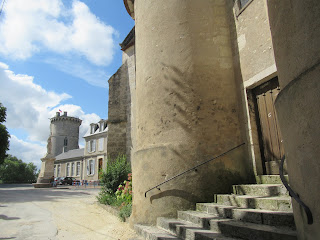Destination: Bourges
The XII and XIII c. Cathédrale St Étienne in Bourges is a marvel, a UNESCO World Heritage Monument, and a symbol of Bourges' rich medieval history. But the town itself goes back even further, to when it was known as Avaricum, and played a significant role in 50 BCE during the Gallic Wars. Even then, it was known as one of the loveliest towns in Gaul.
Definitely worth a visit, and only an hour-plus from me -- if you don't take into consideration having to slow down and indeed occasionally stop for truck traffic and a "convoi exceptionnel" (unusual convoy), such as this:
My route in the traditional, cultural region of "the Berry" (a majorly disputed area between France and England during Eleanor of Aquitaine's day -- 12th C),took me out of the Indre département of the Centre-Val de la Loire region, into the (river) Cher départment.
First stop of note along the way, the charming town of St. Florent-sur-Cher, with its Roman bridge and exquisite Hôtel de Ville (City Hall) and public park on the grounds of a former château (admit it, doesn't it look like Disneyland?):
Then on into Bourges -- a decent-sized city, the heart of which is the medieval center, known primarily for St. Stephen's Cathedral, Jacques Coeur's palace, and the "half-timber" houses (maisons de pan bois), particularly along wonderful Bourbonnoux Street, which connects to the Ramparts. Here are some photos!
First, a number of "streetscapes"--
 |
| I love these "trompe l'oeil" paintings on buildings! |
Most of the old city of Bourges is shops, and this is the sale season (sales are nationally authorized in January and June), so the whole place was looking a bit tacky to me. But where I found beauty and then peace, was on Rue Bourbonnoux with its half-timber and colorful houses and storefronts...
 |
| This a "luthier" shop: someone who makes and repairs stringed instruments. |
 |
| "Maisons de pan de bois" means half-timbered houses. |
 |
| This girl was alone on the street (maybe waiting for someone inside), singing. She had a lovely voice, and I told her so. |
 |
| The sign points out that the street used to be called the "Red Bonnets"street. |
 |
| Look at what he's using to sweep the street (of broken glass)! |
 |
| Ah -- is there anything more photogenic than a used book store? |
 |
| Well, it turns out yes, there is -- brushes! |
,... and the quiet and hidden neighborhood of the Ramparts:
 |
| This woman is gardening in a patch of ground that belongs to the whole community. It's a small community. |
 |
| I SO wanted to go down into this little tearoom...but I'd just had lunch. |
out of Bourges and went a short distance to Mehun-sur-Yvrès, because I read there was another château there. There is, but it's in ruins.
But it's what's NEXT DOOR to the ruins that was the highlight of the trip for me. In 1429 after delivering Charles VII to the cathedral in Reims to be crowned, and winning back Orléans for him, Joan of Arc (Jeanne d'Arc) came to this village. She was 17 years old and at the top of her game. And it was in THIS CHURCH on December 29 of that year, that the king, in appreciation, presented her with the papers that made her and all her family nobles. She left the town in the spring of 1430 to go on to win other battles.
 |
| Plaques like this, naming those who died for France in World Wars I and II, are in every village, town and city. |
But you know, with all the "look at me" power architecture, it was this simple set-up that at the end of the day, truly charmed me:
A la prochaine --
***





























































Comments
Post a Comment